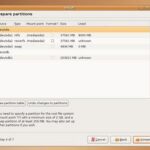Unless you’ve been living underneath a rock for the last 5 years, you may have heard of Ubuntu, the most popular distribution of the Linux operating system. Ubuntu is the easiest version of Linux to use, by far. But how does it square up against Microsoft Windows?
The best thing about Ubuntu, or any version of Linux, is that its free. There are a few things that versions of Microsoft Windows has that Ubuntu does not have. The start menu is missing in Ubuntu. That start menu has been replaced by an interface known as Unity, where the Canonical logo sits in the upper left hand corner of the screen, icons for programs and services line the left hand side of the screen and the time, power icon, volume, internet connectivity, and other items appear in the upper right hand corner of the screen.
There aren’t any icons in Ubuntu on the actual desktop. There is no quick way to see what applications you have installed. As with all versions of Linux, you can use any number of different package managers to install software, or use the command line. Windows users might be intimidated by the command line, but for most software available on Linux there are articles that explain exactly what steps need to be taken to download and install software through the command line. Windows users may not be aware of the fact that the command line can also be used to download and upload files as well as run programs and execute scripts; this is the norm in Linux but the exception to the rule in Windows.
In Ubuntu, you click on the logo and perform a search for everything. Unlike Microsoft Windows XP, Vista, or 7, search returns results found on the Internet for software, multimedia, and products, as well as results found on the computers hard drive of software and multimedia. So a search for Eminem will produce results of his album that can be purchased through Ubuntu’s Music store as well as actual songs you have on your hard drive. This takes some getting used to, but in time, you’ll learn to appreciate the simplicity of the interface.
You can access the computer settings in Ubuntu by clicking on the wrench on the left hand side of the screen. Linux does not show you every single setting, as does Windows. Linux just shows the most basic settings; installed printers, screen resolution, etc. There is no device manager in Linux, no “network connections” or any of those other places in Windows. If you want access to the entire computer, you can access it from the command line or download software that allows you to tweak the computer for performance. The command line can be pulled up through Ctrl-Alt-T, The task manager for Ubuntu is rather confusing, so I installed another task manager that showed me exactly which programs are running, rather than which processes are running. Ctrl-Alt-Del asks if you want to log out of the system; the power button asks if you want to shut the computer down. Both will perform the desired task in 60 seconds, whether you respond to it or not.
Mac OS X users will notice that the look and feel of Ubuntu is very similar to what they’re used to. This is because these operating systems are distant cousins; Ubuntu is based off of Linux, which is based off of Unix, Mac OS X is also based off of Unix. The learning curve from Mac OS X to Linux is not as severe as it is for a Windows user.
In Ubuntu the default method for installing software is the Ubuntu Software Center. This program takes up a lot of system resources. You can use it to find out what software is already installed on your system, and you can also use it to find software you have to pay for as well as free software. Most of what you want is free, there is software for advanced users that are looking for ways to interface Linux with Windows, and other difficult, grueling tasks, that will have to pay for their software, or learn how to use the command line to perform these tasks the hard way. Unless you’re a programmer and like to write your own scripts, I would go ahead and pay a few bucks for software that can make your life a lot easier.
Programs like Google Music Manager and Dropbox are available for Ubuntu. The default browser is Firefox, and Ubuntu allows you to install “web apps”, which are like mobile apps, but just on the desktop. I installed a Gmail app, and I get a little envelope that appears on my desktop whether I have Firefox open or not. I prefer Google Chrome to Firefox though. You are usually better off attempting to download the .deb package for the software you wish to install and using the command line or software that is specifically designed to install .deb files than you are trying to use the Ubuntu Software Center to install everything.
Another area that may confuse Windows users about Linux is the issue of security. In Windows, patches to the operating system provide a basic level of security antivirus software continually runs in the background and provides a deeper level of security against more sophisticated attacks carried out against the operating system. In Linux, vulnerabilities within the operating system are found by programmers on a continual basis, and users are given the chance to update their version with patches to the operating system. Linux refuses execution of software that could be used to compromise the system remotely in the background, and software updates are generally used to address more sophisticated attacks. Antivirus software is not used; it is available, but the chances an end user would ever need it are rather small. Mac OS X, and any other operating systems based off of Unix, work on the same principle.
The need to run antivirus software does add a bit of overhead to Windows system and on some level, does require more computational power than would be needed otherwise. This was a huge issue on older, 9x versions of Windows, and Windows XP. In Windows Vista, 7, and 8, the sophistication of the user interface requires a lot of computational power, and users never get to see their performance compromised by slow antivirus software. The same can be said for Linux operating systems like Ubuntu that provide the most elegant experience possible.
You set your swap file to be as large or as small as you want it to be in Linux.





